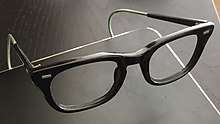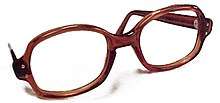GI glasses
GI glasses are eyeglasses issued by the American military to its service members. Dysphemisms for them include the most common "birth control glasses" (also called "BCGs") and other variants. At one time, they were officially designated as regulation prescription glasses, or RPGs. This was commonly said to mean "rut prevention glasses" due to their unstylish appearance.





History
The original version was designed for use with gas masks during World War II. It was wire-rimmed with cable temples and a "P3" lens shape. The design was a modification of the style used by the British military.[1]
After World War II, the material was switched from nickel alloy wire to cellulose acetate. Initially gray cellulose acetate was used, but this was discontinued in 1968, with remaining stocks issued until exhausted. The replacement frames used black cellulose acetate.
In the late 1970s, the lens shape was re-designed to the "S9". Black "S9" frames were released for a brief period,[2] before brown cellulose acetate replaced the black. The brown cellulose acetate frames were discontinued in 2012, and a new smaller unisex lens shape, the "5A", was introduced, with a black frame. The modern "5A" shape was designed by Rochester Optical, who is the exclusive manufacturer of the R-5A frame.[3]
GI glasses are issued at government expense to new recruits at recruit training or Officer Candidate Schools in the United States military. When entering recruit training, service members may wear civilian glasses until government-issued ones are assigned, including but not limited to the BCG. Contact lenses are never permissible for these exercises. After recruit training, service members are permitted to wear Frame of Choice glasses which are conservative in design and color or contact lenses. The military offers annual replacements for those who qualify, and personnel may request the government issued glasses in addition to several varieties of more attractive eyewear, in clear and tinted lenses, as well as prescription gas mask inserts and inserts for government-funded ballistic eyewear.[4]
Women's styles
Manufacturers
- Bausch & Lomb (B&L)
- Randolph Engineering
- ArtCraft
- Titmus
- USS ("Birth Control")
References
- U.S. Army Medical Department, Office of Medical History. "Spectacles". Procurement of Problem Items. The Medical Supply System. Retrieved 2013-04-16.
- "1980s Black only made for short time". Archived from the original on 2013-07-03. Retrieved 2013-04-16.CS1 maint: BOT: original-url status unknown (link)
- "Bye bye BCGs". Retrieved 2013-04-16.
- Rod Powers. "Surviving Air Force Basic Training: Eye Examination and Glasses". About.com U.S. Military. Retrieved 2007-02-11.
- "1960s-1970s Womens". Archived from the original on 2014-12-16. Retrieved 2014-12-16.CS1 maint: BOT: original-url status unknown (link)